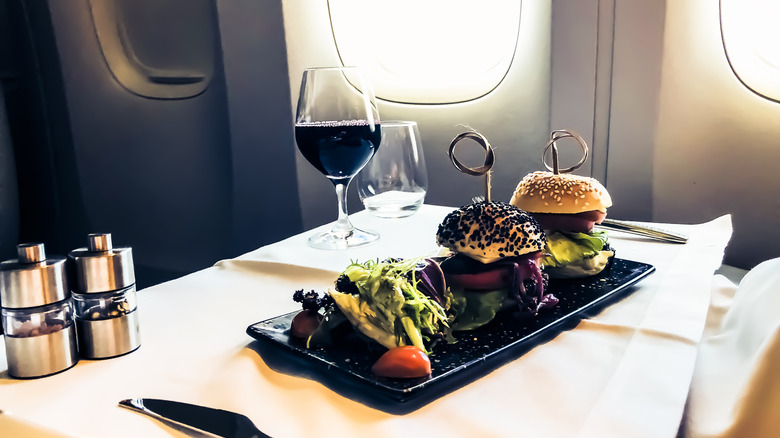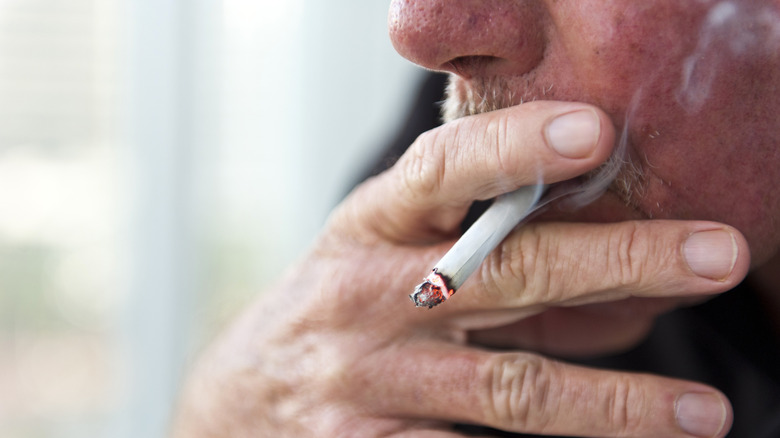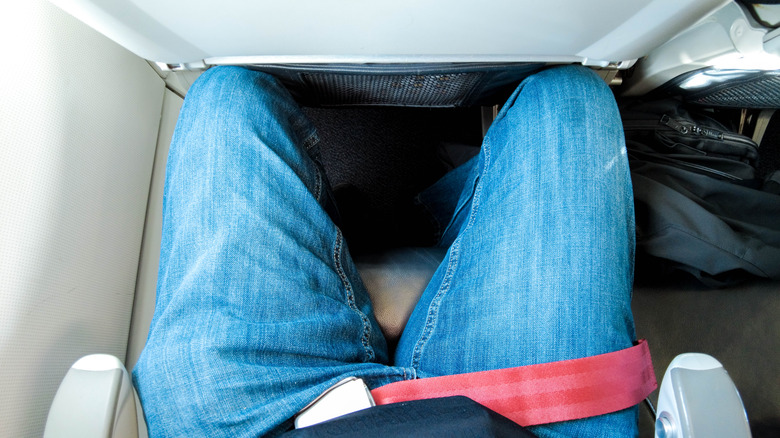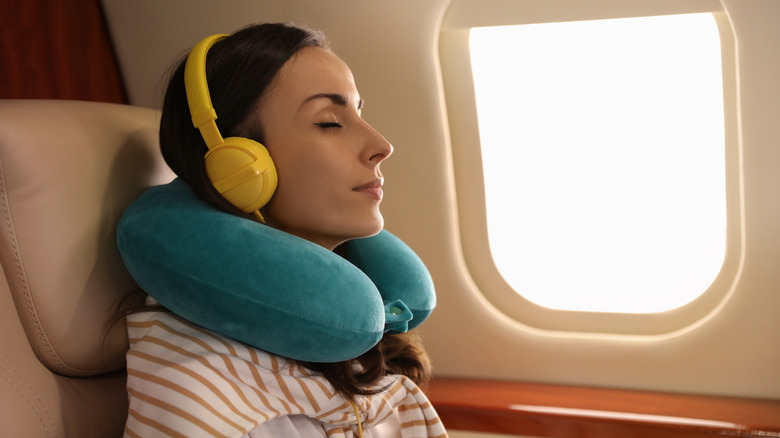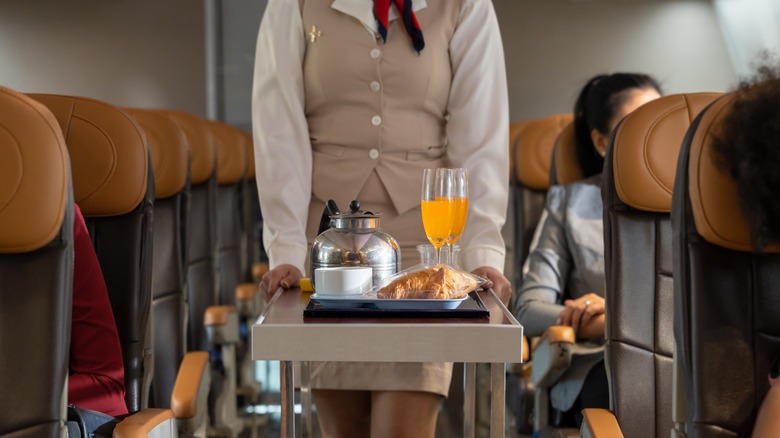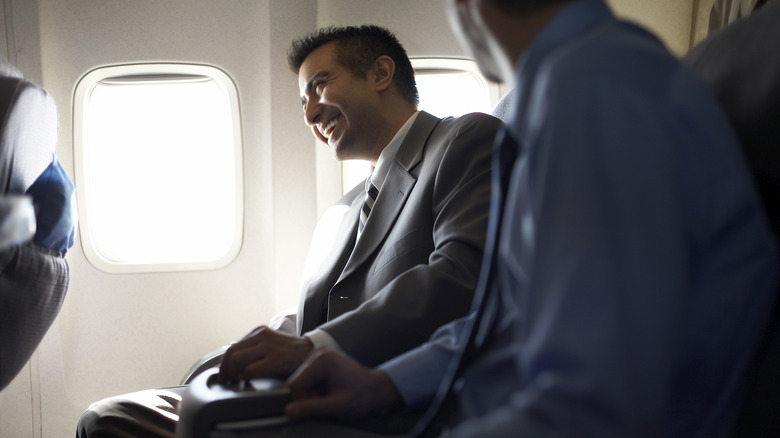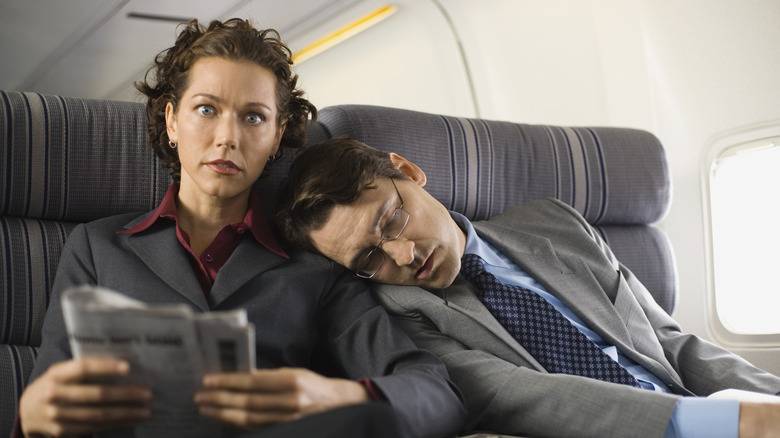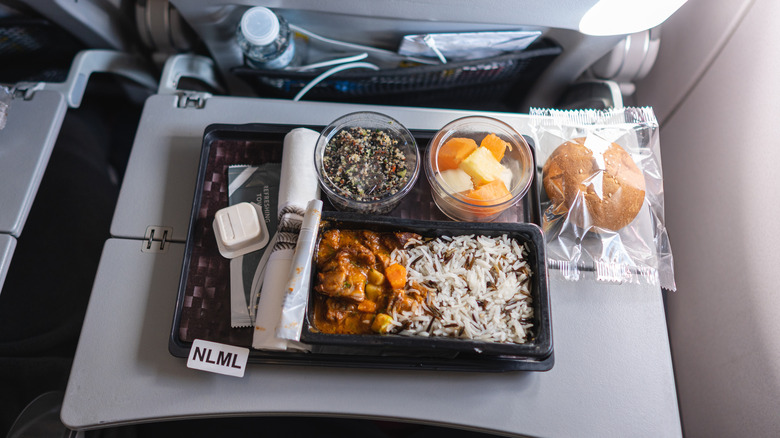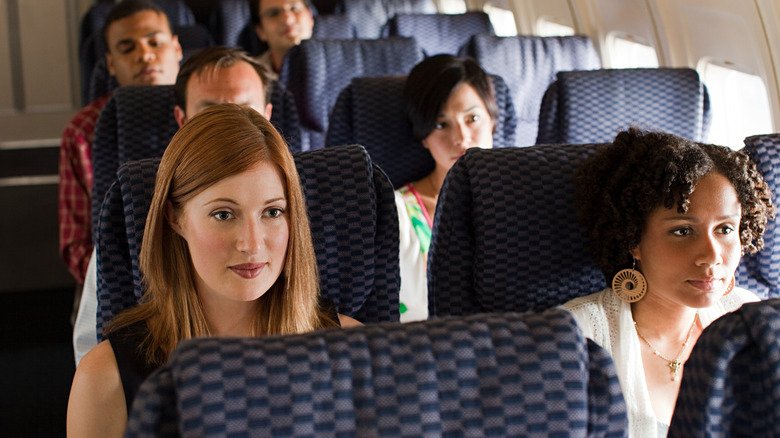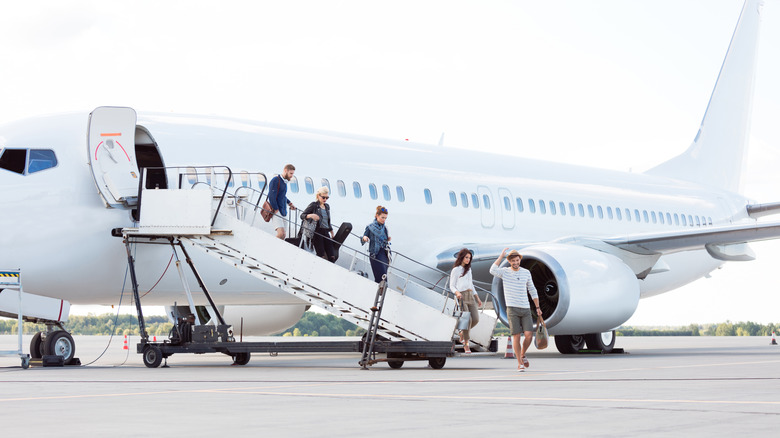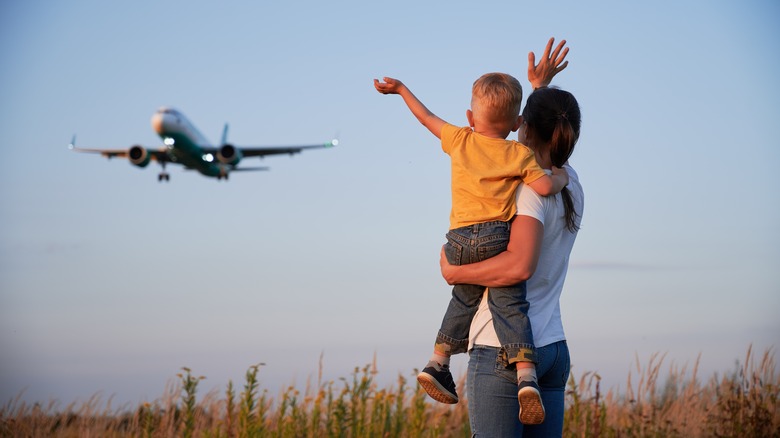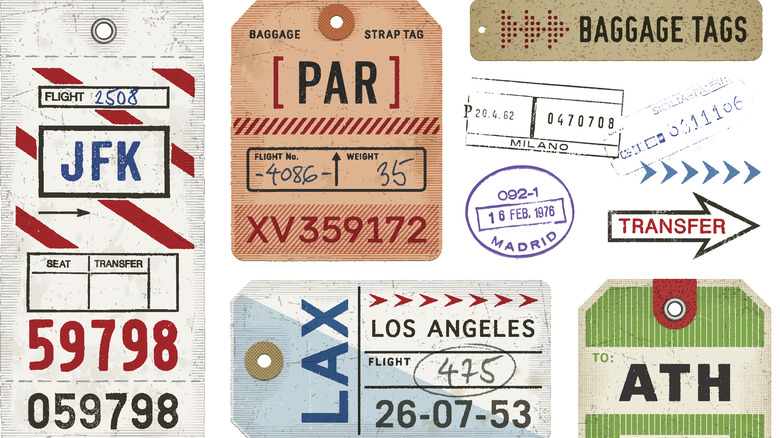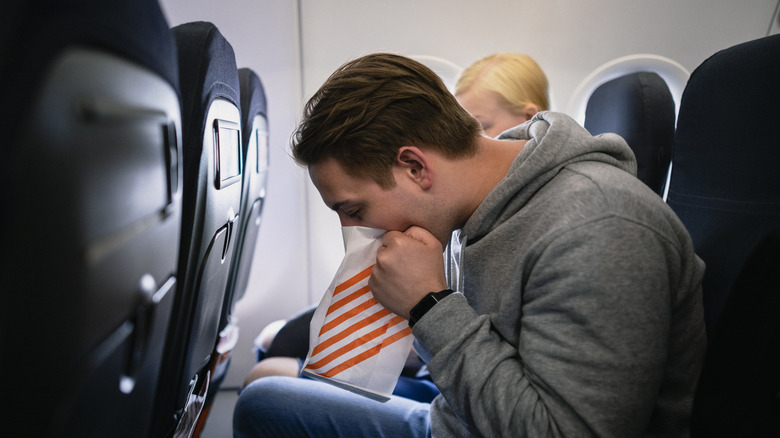Things Airlines Used To Do (But Don't Anymore)
Watch the sky long enough, and you'll spot the distinctive shape of airplanes taking travelers hundreds of miles across Earth pretty frequently. This wasn't always the case, though, as early commercial air travel was a curiosity for many and a reality for few. We live in a time when you could be across the country in an afternoon, but even though the Golden Age of air travel was much slower, it lavishly had its perks.
Speaking with Jack Stahley, a former American Airlines flight attendant, he detailed some of the changes air travel has made over the years. "A lot of airlines gave up on things like varieties of snacks, different beverage options, food on certain flights," he said. While he is speaking of more recent deviations regarding in-flight benefits, 50 to 70 years ago, the experiences found within an airplane were much more grand. Fine dining and comfort you wouldn't fathom in the modern travel world awaited those early, well-dressed flyers.
No matter where in the air travel industry's timeline you look, things have surely changed. Our attitude and expectations about traveling on a plane have been molded by how airlines have been modernized. Whether for better or worse, we've uncovered some things airlines used to do that new travelers will likely never see.
Allow smoking
Smoking used to be commonplace and even encouraged, pretty much everywhere. Offering someone a light or cigarette was seen as a polite thing to do or a great icebreaker. Some airlines would even provide cigarettes to passengers as a courtesy. If this sounds like something straight out of "Mad Men," then that's because the tobacco industry and airlines were intermingled quite a bit when it came to marketing. Air travel was glamorous back when cigarettes were being pushed, and the two industries regularly partnered to create a laid-back, luxurious aesthetic.
Even when the public became wise to the harmful effects of smoking, airlines still had a substantial smoking section on their planes. The iconic, lost-in-time airline Pan Am trained flight attendants on the rules surrounding these smoking areas. The vintage instructional video "The Smoker" taught flight attendants how to handle smokers who didn't want to follow what were then the new rules. In the video, it's clear how commonplace smoking was on airplanes.
If you were to take out a cigarette or ask for a light on a plane today, people would look at you like you were from a different planet. While you can still legally pack cigarettes in your carry-on bag and bring them onto the plane, smoking them is banned — despite ashtrays remaining on board. Considering the dangers of secondhand smoke and the flammable nature of cigarettes, this is one fad of the past that can stay there.
Have ample leg room
One of the most consistent complaints about modern-day air travel is the lack of legroom, especially for long-haul travelers. Stretching your legs is likely to end in a game of footsie with the passenger in front of you. The amount of room passengers have been given in standard plane seats is borderline impossible to feel comfortable in, but this certainly was not always the case.
Planes used to be smaller and they held far fewer passengers. They were also made for much more than just profit-mongering or packing in as many seats as possible. Planes were built to provide comfortable, luxurious experiences. And it's kind of hard to sit in the lap of airline luxury when your knees are hitting the back of the seat in front of you. Modern-day plane seats are between 29 and 32 inches apart, at least three inches smaller than the 35 inches they used to be. If you want that coveted extra space now, you'll have to pay for an upgrade.
Encourage socialization between passengers
Boarding a plane is almost like entering a completely different social universe. The inside of a modern-day plane is oddly quiet, thanks to its insulated walls that keep out the roaring engine noises and passengers' proclivity to say as little as possible. There's nothing that closes a person off to interaction quite like the neck pillow, headphones, and sleep mask combo. It's not abnormal to see this on a plane, but back in the Golden Age of air travel, planes were more like a lounge where socialization was easy and encouraged.
Passengers talked and laughed together while in their seats back in the day, but airplanes also had lounge areas in which passengers could form connections. Traveling via plane was less laser-focused on the destination and more on the social status of the flight experience. Travelers could hang out together in lounges with restaurants and bars while flying high. The closest thing to this experience in most modern-day planes is ordering a drink with the flight attendant and toasting your neighbor — if they've forgone the sleep mask and neck pillow, that is.
Provide top-tier luxury meals
These days, you'll be lucky if you're asked between vegetarian and non-vegetarian for an inflight meal. In the Golden Age of flying, it wasn't abnormal for a flight attendant to carve prime rib from the cart. Those onboard social lounges often served multi-course meals with fine wine or spirits.
Today, passengers on shorter flights are offered a choice of drink and a packet of pretzels for good measure. Food fit for a picnic is sometimes offered for purchase, but even this would have been scoffed at by those jet-setting in air travel's hay day. Instead, they were met with lavish meals of three or four courses. Meals were prepared during the flight. You could even receive made-to-order eggs. The ingredients were varied and balanced — you'd think there was a full-service kitchen tucked away in the back of the plane.
In some cases, technological progress is supposed to improve standards, so why has airplane food taken a plummet in quality over the decades? Simply put, airlines don't really need to impress passengers anymore. Flying is commonplace and necessary for many, making price the most important aspect for many when booking flights. Airlines soon figured out what they could offer as cost-effectively as possible. Shockingly, that wasn't lobster and lamb.
Have dress codes
The standard today for many is to travel in comfort, and you're likely to see more sweatpants than slacks on modern planes. Passengers used to head to the airport wearing their finest outfits. Though most people also wanted to impress when heading to the airport, they were also required by the airline's dress code to present themselves in such a way.
Okay, so technically, you could still get "dress-coded" at the gate. As long as you don't plan on boarding your plane without shoes, with tons of skin showing, or in a shirt portraying crude or offensive material, you shouldn't have a problem. In a way, this is asking the bare minimum of passengers, but a flight attendant won't look twice if you board in flip-flops and jean shorts. You won't stick out in a suit, though. For those flying business class, smart attire is encouraged, but it is typically still a matter of personal opinion and comfort level. However, there is one piece of apparel flight attendants warn against wearing.
Provide sleeping spaces
If you're jealous of the legroom you would have had flying 50 years earlier, then this will just make you mad. Instead of a spacious baggage area, planes used to have an upper compartment where passengers could lie down and sleep on their long flights. These sleep areas were pretty bare with just a thin mattress, pillow, blanket, and privacy curtain. A bed's a bed, though, and would be an absolute luxury for modern travelers.
Travelers who have been on a plane for more than a few hours have almost certainly chosen between sleeping upright or the neck-straining, head-against-the-wall sleeping position. Or, maybe you've woken up with your head on a stranger's shoulder. Either way, sleeping on a plane is rarely ideal. These days, plane seats barely recline in a halfway-comfortable position. When they do, though, the dilemma of encroaching on the passenger behind you rears its head. Travelers of decades past didn't have these worries.
Serve food and drinks in fine china
The idea of drinking wine out of a paper or plastic cup would have shocked passengers back in the '50s. No, it was only the finest for those who could afford to jet-set across the world in a plane. Air travel used to be elite, so only the wealthy could purchase the pricey tickets, and for the hefty price of air travel, food and drinks were served on fine china and in real glasses.
You may luck out and receive a glass of whiskey in, well, a glass if you order an in-flight drink. However, plastic is going to make an appearance in a big way if you receive a meal. Plastic-wrapped disposable silverware, single-use containers, and individually wrapped sauces, condiments, and salt packets will litter your tray table. Your water will likely come to you in a plastic cup, and your soda in a can.
We get it. Feeding hundreds of passengers with expensive and breakable plates isn't the most feasible option. A plane doesn't exactly have a dish pit hidden away somewhere, either. The trade to disposable makes a lot of sense, but we can't help being wistful for the days when your in-flight muffin would come on a cute, printed saucer.
Discriminate
The Golden Age of flying may sound amazing at the surface, but all things gilded may not be as precious as they seem. Sadly, discrimination was alive and well in the travel industry, and airlines were complicit. Airports were segregated through the '60s and flying was predominantly utilized by white people. Black people did not have the same accommodations in airports and were regularly bumped from planes. This could cause serious delays in a person's travel, and if bumped on a connecting flight, travelers could be stranded for days.
What would be seen as unacceptable now, was just a drop in the bucket for Black travelers then. We have come a long way in a relatively short time, but discrimination is still found in our world. Fortunately, you'll find that planes are now highly diverse places with passengers hailing from all over the world and with all shades of skin colors.
Passengers were not the only ones to face discrimination in the air travel industry in years past. Flight attendants were under strict scrutiny at work as well, having to fit within various standards set by their particular airline. "If you got married, got pregnant, or reached over 25, you had to quit," says Jack Stahley. "You had to weigh a certain weight and would have to weigh in before you went to work." This was true up until the '90s. While progress has been made, there's still a sad reality of how flight attendants are paid.
Let passengers off right at landing
Touchdown can be such a thrilling moment. You've arrived at your destination after having your butt firmly planted in some famously uncomfortable seats for hours! Arrival doesn't automatically mean you're free to start the frenzy to the door, though. These days, you can land safely but still remain on your plane for an absurd amount of time. Often, the unbearable wait time can be due to not having space at a gate for the plane to park. Back in the '60s, this used to be completely avoided by the addition of roll-away flight stairs.
On and off-boarding used to be much simpler when it came to air travel, as passengers could walk right up to the plane with their luggage and step right up these moveable stairs for their flight. Flights were more streamlined, and it was a simpler time. Now, of course, there are so many moving parts at an airport with increased flights and heavier security that such a relaxed approach is next to impossible.
Allow for last-minute goodbyes
The intense, post-9/11 security measures at airports are pretty much standard at this point, but there are some that still remember how travel was before the tighter regulations. While loved ones who aren't traveling together have to say their goodbyes before security checkpoints, they used to be able to get much closer. Goodbyes used to be shared right on the tarmac, thanks to those roll-away stairs and loose security measures.
Having your loved ones with you right up until you board may complicate the security of the airport. However, it could do wonders in making passengers feel secure. For first-time flyers especially, air travel can be stressful. A chunk of that stress comes from sorting through the maze of an airport. If you are traveling solo and flying alone, the first departure can be extra anxiety-inducing. The comfort of having those you trust to lean on before accessing the gate would surely make flying a bit more soothing.
Attach collectable luggage tags to baggage
Airlines used to be incredibly fun, with epic marketing campaigns, brightly colored uniforms, unique airplane paint jobs, and small touches that set them apart from other airlines. One such specialized touch was their baggage tags, which were highly coveted and could be kept as collectibles by passengers. Each airport had its own special design that airlines would stamp and affix to bags, which some travelers would consider a lot cooler than a stamp on your passport.
Having a collection of luggage tags from your journeys was a great way to remember and bookmark your trips, and the colorful tags allowed travelers to show off how well-traveled they were. Unlike a passport stamp, tags could be displayed as a subtle nod to their worldliness. The tags may not be worth a fortune in resale value, but they're probably priceless to the travelers lucky enough to have collected them.
Carry barf bags
You've probably seen the barf bag scene in countless movies, and have likely heard of the practice of breathing in and out of a paper bag to calm nerves. Planes used to carry similar, plastic-lined bags for nervous or air-sick passengers, but you will find that they are a rarity now. The reason a lot of airlines no longer carry barf bags is that, thankfully, they are no longer really needed.
It turns out that getting air sick is a thing of the past, at least for the most part. With advancing technology in the air travel industry, some of what would cause air sickness has been eliminated. Airplane cabins are now pressurized, which means they can fly at higher altitudes. This has drastically decreased turbulence on flights. This, combined with flying becoming more common and less fear-inducing, has helped eliminate some of the nausea caused by flying.
Like most things, the lack of barf bags comes down to money as well. Airlines have started to reduce costs where they can, and the elimination of barf bags saves a bit of dough. Apparently, the cost of the bags outweighed the now-lessened risk of sick passengers making a mess.
